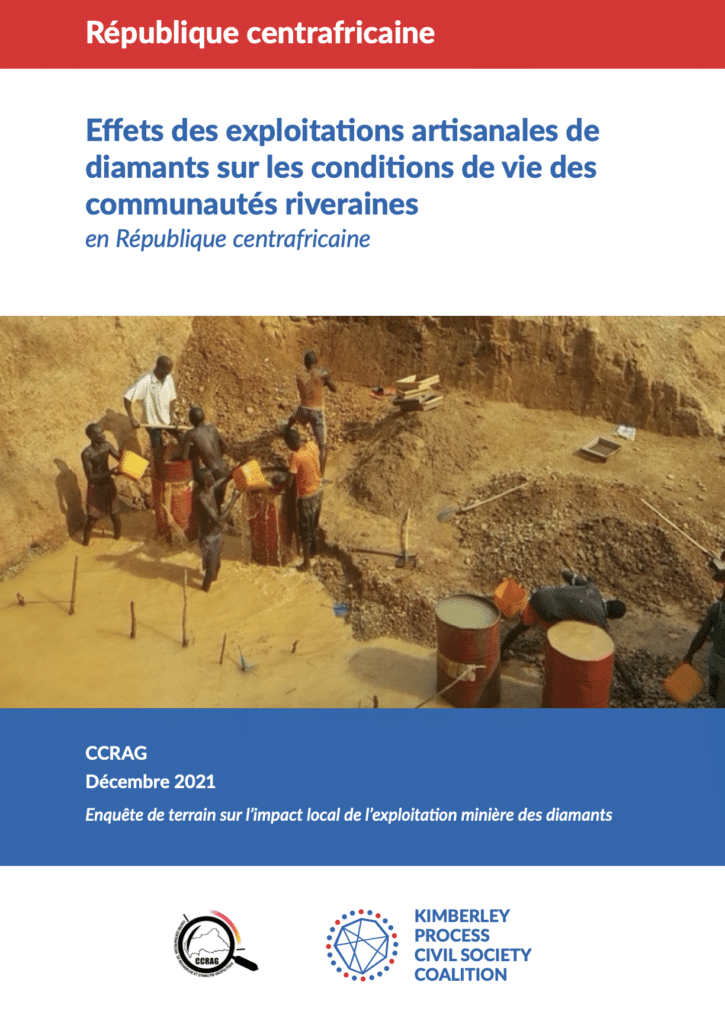During 2021, IPIS supported members of the Kimberley Process Civil Society Coalition (KP CSC) in a series of grassroots studies on the human rights, socio-economic and environmental impact of diamond mining in eight African countries. IPIS provided online trainings on field survey methodology as well as editorial support to ten civil society organisations who carried out independent field research and data analyses. The studies combined newly-collected primary data – collected through field surveys – with secondary data sources to provide key insights on the realities of mining communities and communities near diamond mining sites.
The objective of the project was to improve the understanding of real-life impacts of the national artisanal or industrial diamond mining sectors in these diamond producing countries and to formulate clear recommendations to governmental, industry and civil society stakeholders in order to enhance human rights, traceability, accountability and sustainability in the diamond supply chain.
Large-Scale Diamond Mining in Lesotho: Unpacking its Impact on Adjacent Communities
In Lesotho, MCDF (Maluti Community Development Forum) investigated the impact of large-scale diamond mining on adjacent communities. Diamond-affected communities from 19 villages in the mining region of the Maluti Mountains reported environmental pollution, the lack of employment opportunities and insufficient Corporate Social Responsibility (CSR) measures as key issues. The study also revealed alarmingly high levels of nitrate in water samples taken near the Letseng mine tailing sites that link to key water sources for communities in Letseng and Maloraneng villages. MCDF calls on the government and mining companies to address and prevent the adverse impacts of diamond mining, through meaningful due diligence and consultation processes, amongst other strategies.
Effects of artisanal diamond mining on the living conditions of local communities in the Central African Republic
In the Central African Republic (CAR), CCRAG (Centre Centrafricain de Recherche et d’Analyse Géopolitique) studied the effects of artisanal diamond mining on the living conditions of local communities in the towns of Boda, Nola et Berberati (south-west CAR). There, a total of 42 mining sites were visited. The report sheds light on the impact of artisanal diamond mining on the environment (pollution), livelihoods and social aspects in mining communities, and emphasises the role of national authorities in increasing the economic potential of the sector through a better control over the diamond trade.
Mapping the Economic and Social Challenges of Artisanal and Small-Scale Diamond Mining in Côte d’Ivoire: A Case Study of the Seguela and Tortiya Areas
In the Republic of Côte d’Ivoire, GRPIE (Groupe de Recherche et de Plaidoyer sur les Industries Extractives) mapped the economic and social challenges of artisanal and small-scale diamond mining in the areas of Seguela and Tortiya, the two main diamond producing areas of the country. Data was collected in 17 mining sites. The research shows that diamond mining communities experience economic hardship due to the decline of diamond production, leading to workforce migrations towards the gold mining sector. The study includes testimonies of how artisanal diamond mining can be an effective and efficient means of fighting poverty and stimulating development.
Vulnerability of Artisanal Diamond Miners in Guinea: Mapping and Remediation Needs. Case studies in Macenta, Kérouané and Forécariah
In the Republic of Guinea, Action Mines Guinée and CEDIDE (Centre du Commerce International pour le Développement) examined the vulnerability of artisanal diamond miners through case studies conducted in 38 sites in Macenta, Kérouané and Forécariah. Results show that artisanal diamond mining benefits tend to be undermined by the low level of formalisation within the sector. In order to reduce the vulnerability of miners, the study made recommendations to key actors in the artisanal diamond mining chain in the Republic of Guinea.
The impact of artisanal and small-scale diamond and gold mining on the environment in Kasai-Oriental and Tshopo provinces of the Democratic Republic of Congo
GAERN (Groupe d’Appui aux Exploitants des Ressources Naturelles) and CENADEP (Centre National d’Appui au Développement et à la Participation Populaire) analysed the impact of artisanal and small-scale diamond and gold mining on the environment in Kasai-Oriental and Tshopo provinces of the Democratic Republic of Congo. Water pollution and soil degradation are flagged as the two main challenges to a sustainable supply chain. The study calls upon the Congolese government to better regulate and support communities in sustainable management of the environment.
The challenges characterizing Sierra Leone’s artisanal diamond mining sector – and why the sector should be formalized
In Sierra Leone, the Network Movement for Justice and Development (NMJD) surveyed a representative sampling of 21 artisanal mining sites to analyse the opportunities and challenges to the formalisation of the diamond sector in the country. NMJD’s analysis of the characteristics of the artisanal diamond mining sector sheds a light on some legislative, socio-economic and operational challenges.
State of play and mapping of diamond mining sites in Eastern Cameroon
In Cameroon, the Réseau de Lutte contre la Faim (RELUFA) carried out a mapping exercise to locate artisanal diamond mining sites in Eastern Cameroon, understand which actors frequent and monitor them and, study the socio-economic and environmental characteristics of the diamond production and trade. The study highlights that diamond production in the region is both low and very difficult to trace as miners tend to work on unregistered sites and sell their production to informal buyers. Moreover, the lack of buying offices in Eastern Cameroon leads artisanal miners to sell their production to buyers in the neighbouring Central African Republic. Formalisation is therefore identified as key to improve traceability, as well as tax collection and redistribution.

These documents have been produced with the financial assistance of the European Union. The content of these documents are the sole responsibility of the authors and can under no circumstances be regarded as reflecting the position of the European Union.









